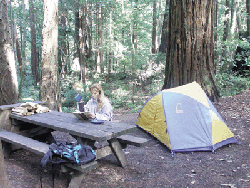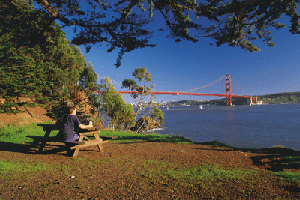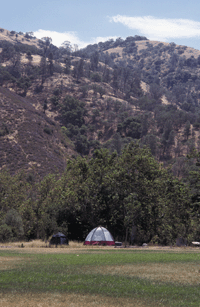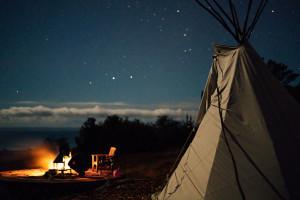Dusk has fallen. Darkness envelops my campsite as I watch the woods around me fade into shadow…
The temperature drops and stars pierce the darkening sky. I build a small campfire and warm myself, savoring the experience of sitting quietly outside as day turns to night. Here in the densely inhabited San Francisco Bay Area, we are fortunate to have so many places to sleep outside in nature within such close reach. A world of unparalleled natural diversity protected by more than 200 parks, preserves, and wilderness areas, the Bay Area offers upwards of two dozen public drive-in campgrounds and 30 hike-in backcountry trail camps. All are less than a two-hour drive from anywhere in the region (far closer than any campground in the Sierra Nevada). No other urban center in America can match this potential for nearby, readily accessible camping adventures.
I’ll admit that it can be a challenge to escape from the busy work-focused world and get out here. But it really shouldn’t be, given how easy it is to make the trip…
As the campfire burns to embers and cooler temperatures creep in, I enjoy the warmth of an evening meal. Afterwards, I extinguish the glowing coals and store my food in the provided locker—scavenging raccoons will find nothing of interest here tonight. Camp secure, I slip inside the tent and cocoon within my warm sleeping bag. Adjusting my body to the contours of the ground beneath, I lie comfortably in the night and listen to the sounds of the natural world outside the thin nylon membrane of my tent.
On this particular trip, convenience has trumped effort. I’ve opted for a drive-in campground rather than a backcountry trail camp, choosing the convenience of easy vehicle access and amenities like flush toilets, showers, and campfire rings. And after all, this is just a one-night, two-day escape. A several-day trip to a backcountry trail camp would have provided deeper immersion in the natural world, but also would have required hiking one to seven miles with overnight gear on my back (a.k.a. effort). The drawback to the drive-in campground is sharing the overnight experience with other nearby campers and their noise. But this is a weeknight; most sites are empty and the sounds of human activity are barely perceptible. I hear instead the scurryings of mice on the forest floor, the padding step of an inquiring raccoon, and then, as I fade away, the great horned owl calling once again….
The diffuse light of morning fills my tent as I awaken to songbirds welcoming the day. Emerging, I find the campground quiet and still slumbering. The few weekday hikers and picnickers won’t arrive for hours yet. Miles of empty trails stretch in every direction. I brew a pot of thick camp coffee and set out on a nearby path. Finding a bench in a small grove of trees, I sit and enjoy the hot drink as the forest warms with the rising sun. The morning solitude is precious, and I linger for some time before returning to camp.
After a leisurely breakfast, I pack up my gear and prepare for a long hike. No need to struggle through traffic and drive to the trailhead this morning; I’m already here. On this quiet weekday, the park is all but empty, and I can explore it at my leisure. Were it a weekend or holiday today, the park would be exponentially busier and the campground likely full by advance reservation. Then again, for those with the foresight to make advance reservations, this would be a perfect place for gathering friends and family—in a location that’s much less crowded, and much more inspiring, than the dining room back home.
At the end of a day on the trail, I return to the car for the drive home. I am reminded that despite our sincerest efforts to make each day longer and fill it with more activities, errands, and meetings, the sun continues to set and rise on the same cycle. Instead of feeling powerless at my inability to slow time, I feel privileged that nature has allowed me to tag along for a night and a day. That I could sleep when the world darkened, and wake as it grew brighter, has provided a much-needed respite from my everyday reality and a reminder of an enduring world just beyond my daily routine. With gear in tow, I prepare to return to my place in the bustling human landscape.
Overnight Adventures Close to Home
The Bay Area is blessed with a variety of ecosystems protected in public open space. Here are three different landscapes that offer us the opportunity to experience their unique charms by spending the night in their wild embrace.
Coastside
Defining the western edge of the Bay Area, this dramatic interface of land and sea beckons year-round. Green grass and wildflowers flourish in the spring, cloaking fog competes with sunshine throughout the summer, warm sunny fall days dry the land to golden brown, and dramatic storms alternate with periods of breathtaking clarity throughout the winter. Two featured destinations offer overnight coastal adventures—Kirby Cove in the Marin Headlands (Golden Gate National Recreation Area) and Wildcat Camp in Point Reyes National Seashore.
- Kirby Cove campground’s exceptional view of the Golden Gate. Photo by Alasdair McCondochie.
Restless natural energy pulses through the Golden Gate, a flood of fresh water mingled with the salty swell of the Pacific. On its steep northern flanks, an isolated valley traces downward to reach the shore and the small campground of Kirby Cove. Accessed via a 0.9-mile one-lane dirt road inaccessible to RVs and trailers, the campground provides four spacious sites beneath the branches of a sheltering Monterey pine forest. Each site is a short walk from the small beach at Kirby Cove, which offers exceptional views of the Golden Gate Bridge and the northern face of the city. (If it’s obscured by fog, the deafening foghorns clearly announce the bridge’s presence.) Between the beach and the campground stands the concrete bulwark of Battery Kirby, built at the turn of the 20th century as part of an extensive chain of coastal fortifications surrounding the Golden Gate.
Less than a hundred yards offshore from your tent, tidal currents can rip at speeds in excess of seven knots…
The Details: Kirby Cove is managed by the Golden Gate National Recreation Area, Special Park Use Group. Reservations are required and can be made up to 90 days in advance, (800) 365-2267, $25/site. Campground closed November to March.
Other coastside overnight adventures: North of San Francisco: Coast Campground (Point Reyes NS); Angel Island, China Camp, Mount Tamalpais (Steep Ravine), Fort Ross (Reef), and Salt Point State Parks; Sonoma Coast State Beach (Bodega Dunes and Wrights Beach). South of San Francisco: Half Moon Bay State Beach, Seacliff State Beach (Santa Cruz).

- Camping at Portola Redwoods State Park. Photo by Ann Marie Brown.
The Redwood Forest
Portola Redwoods State Park
Moving across the duff of the moist forest floor, a California newt clambers deliberately away from its birth stream. Overhead, redwood branches radiate from fluted trunks and strain moisture from the passing currents of a spring fog. A visitor from the nearby campground pauses to watch and listen as drops of water patter to the ground and sustain a vibrant understory of tanoak, huckleberry, sword ferns, and sorrel. A cool shroud envelops the forest as the newt moves steadily onward…
Slicing through the western Santa Cruz Mountains, Pescadero Creek flows down a canyon more than 2,000 feet deep that shelters a secluded world of giant trees and luxuriant forest. Portola Redwoods State Park protects a wilderness core of this deep drainage and offers both a drive-in campground and a trail camp 2.5 miles farther into the forest.
Located at road’s end in the bottom of the canyon, the park’s campground is accessed via a dramatic 2,000-foot descent from the crest of the Santa Cruz Mountains. RVs and trailers are not recommended on this steep and narrow access road, making the 53 campsites far more popular with car campers than with motor home owners. Spread along a small tributary of Pescadero Creek, the campground is surrounded by beautiful redwood forest. The fibrous trunks of redwoods, the rough bark of Douglas-fir, the large spiny leaves of tanoak, and the small serrated leaves of huckle-berry bushes define this landscape, joined by the occasional madrone, canyon and coast live oak, and creekside big-leaf maple. Those unfamiliar with the plants of the redwood forest will enjoy the 0.75-mile interpretive Sequoia Nature Loop that begins at the visitor center, winds its way across Pescadero Creek, and visits some impressive old-growth redwoods…
The Details: Portola Redwoods State Park, (650 948-9098, www.parks.ca.gov. Park visitor center open daily in summer; in the off-season open Friday-Sunday, sporadically the rest of week. Campground is closed in winter; reservations essential in summer and can be made up to seven months in advance; (800) 444-park or www.reserveamerica.com. Campground $16/site. For backcountry trail camp reservations, contact the park directly, $10/site.
Other overnight adventures in the redwood forest: In the North Bay: Samuel P. Taylor and Mount Tamalpais State Parks; Austin Creek State Recreation Area. In the Santa Cruz Mountains: Memorial, Pescadero Creek, Sanborn, and Mount Madonna County Parks; Butano, Big Basin, Castle Rock, and Henry Cowell Redwoods State Parks.
Oak Woodlands
Del Valle Regional Park and the Ohlone Trail
…Softly flowing through a broad valley of beautiful trees, ephemeral Arroyo Del Valle curves through the large campground before reaching Lake Del Valle. Surrounding the lake are nearly 4,000 acres of parkland in a land of intense seasonal change. Each year the park courses through dramatic cycles of lush rain and baking heat, vibrant greens and tawny browns, pressing crowds and empty trails. Secluded in the hills eight miles south of Livermore’s suburban sprawl, the park is inviting year-round.
Dammed in 1968, Lake Del Valle is a substantial body of water with more than 15 miles of shoreline from which park visitors can swim, fish, and launch nonmotorized boats. Surrounding the lake are miles of trails for both hiking and biking, skirting the lakeshore and winding through the vibrant oak woodlands that cloak the landscape…
The Details: Del Valle Regional Park, (925) 373-0332, www.ebparks.org. Campground reservations can be made up to 12 weeks in advance, (510) 562-2267. $15/site. A permit ($4) is required to use the Ohlone Trail and is available at Sunol and Del Valle, or through the East Bay Regional Park District reservation office; for information and trail camp reservations ($5 per person per night), call (510) 636-1684 8:30 a.m.-4 p.m. Mon.-Fri.
Other overnight adventures in oak woodlands: In the North Bay: China Camp, Bothe-Napa, and Sugarloaf Ridge State Parks; Austin Creek State Recreation Area. In the East Bay: Mount Diablo State Park; Black Diamond Mines and Anthony Chabot Regional Parks; Sunol Regional Wilderness. In the South Bay: Joseph D. Grant and Coyote Lake County Parks; Henry W. Coe State Park.
A note on reservations and planning: Popular campgrounds in the Bay Area, including those described above, are usually fully reserved on weekends from April through October—plan as far in advance as possible. Weekdays see lighter use, and space is usually available on much shorter notice. Also, pending state budget cuts may affect the opening dates of some state park campgrounds and fees charged for campsites. It is always advisable to call ahead for up-to-date information.

.jpg)





